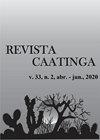覆盖作物及生物防治剂在大豆线虫防治中的应用
IF 0.9
4区 农林科学
Q3 AGRONOMY
引用次数: 1
摘要
摘要在巴西塞拉多,植物线虫、植物线虫对农业来说是一个挑战,而控制形式的结合是与这种病原体共存的最佳策略。面对这一问题,本研究旨在评估覆盖作物和生物防治剂在大豆线虫管理中的效率。对于所研究的每一种线虫物种(南方根结线虫和短吻Pratylenchus brachyurus),在温室条件下以完全随机的设计进行了两个实验,以6×2因子方案安排,共8次重复。对6种覆盖作物(小米ADRG 9050、小米ADR300、酸橙花、赤杨和玉米杂交种DKB290)和2种处理(是否用枯草芽孢杆菌和甲基营养芽孢杆菌处理-每粒种子1×106CFU)进行了评价。将覆盖作物播种在线虫肆虐的土壤中,然后将大豆播种在稻草下,分别对隐姓埋名M.incognita和短尾P.brachyurus培养45天和60天。对新鲜根质量、总线虫种群和每克根的线虫数量进行了评估。微生物与壮观C.spectabilis、ruziziensis和小米ADR300的结合赋予了减少短尾P.brachyurus种群的额外作用。对于隐姓埋名的M.incognita来说,这种结合只有在壮观C.spectabilis和甲基营养B.methytrophicus结合时才成功。与未接受生物处理的植物相比,用甲基营养芽孢杆菌处理的DKB290玉米每克大豆根的线虫数量减少了90%。本文章由计算机程序翻译,如有差异,请以英文原文为准。
Cover crops and biocontrol agents in the management of nematodes in soybean crop
ABSTRACT In the Brazilian Cerrado, phytonematodes, phytonematodes are a challenge for agriculture, and the association of forms of control is the best strategy to be used in coexistence with this pathogen. Faced with this problem, this study aimed to evaluate the efficiency of cover crops and biocontrol agents in the management of nematodes in soybean. For each nematode species under study (Meloidogyne incognita and Pratylenchus brachyurus), two experiments were carried out under greenhouse conditions in a completely randomized design arranged in a 6 × 2 factorial scheme with eight replications. Six cover crops (millet ADRG 9050, millet ADR 300, Urochloa ruziziensis, Crotalaria ochroleuca, C. spectabilis, and corn hybrid DKB 290) and two treatments (treated or not with Bacillus subtilis and B. methylotrophicus - 1×106 CFU per seed) were evaluated. The cover crops were sown in soil infested with nematodes and then soybeans were sown under the straw, and cultivated for 45 and 60 days, for M. incognita and P. brachyurus, respectively. Fresh root mass, total nematode population, and the number of nematodes per gram of root were evaluated. The association of microorganisms with C. spectabilis, U. ruziziensis, and millet ADR 300 conferred an additional effect in reducing the population of P. brachyurus. For M. incognita, the association was successful only for combining C. spectabilis with B. methylotrophicus. DKB 290 corn, when treated with B. methylotrophicus, had the nematode population per gram of soybean root reduced by 90% compared to plants that did not receive biological treatment.
求助全文
通过发布文献求助,成功后即可免费获取论文全文。
去求助
来源期刊

Revista Caatinga
AGRONOMY-
CiteScore
2.10
自引率
11.10%
发文量
67
审稿时长
6-12 weeks
期刊介绍:
A Revista Caatinga é uma publicação científica que apresenta periodicidade trimestral, publicada pela Pró-Reitoria de Pesquisa e Pós-Graduação da Universidade Federal Rural do Semi-Árido – UFERSA, desde 1976.
Objetiva proporcionar à comunidade científica, publicações de alto nível nas áreas de Ciências Agrárias e Recursos Naturais, disponibilizando, integral e gratuitamente, resultados relevantes das pesquisas publicadas.
 求助内容:
求助内容: 应助结果提醒方式:
应助结果提醒方式:


